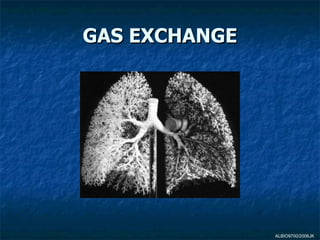
GAS EXCHANGE: THE LUNGS AND RESPIRATORY SYSTEM
- 1. GAS EXCHANGE ALBIO9700/2006JK
- 2. The gaseous exchange system Cleans and warms air that enters during breathing Maximises the surface area for diffusion of O2 and CO2 between blood and atmosphere Minimises the distance for this diffusion Maintains adequate gradients for this diffusion ALBIO9700/2006JK
- 3. The Respiratory System Nasal cavity: air passing over the A flap of elastic mucous membrane of tissue that the nasal cavity is forms a lid moistened, warmed over the and filtered opening of the trachea Passage where the nose and mouth come together Contains 2 ligaments (vocal cords) that produce sound when air move through them ALBIO9700/2006JK
- 4. Lungs Site of gaseous exchange between air and blood Presents a huge surface area to the air that flows in and out In the thoracic (chest) cavity surrounded by airtight space containing fluid to allow friction-free movement ALBIO9700/2006JK
- 5. Alveoli Have very thin epithelial lining Surrounded by many blood capillaries Alveolar walls contain elastic fibres which stretch during breathing and recoil during expiration to help force out air – allows alveoli to expand ALBIO9700/2006JK
- 6. Alveoli (cont) ALBIO9700/2006JK
- 7. Gas exchange in alveoli ALBIO9700/2006JK
- 8. BRAIN TEASER How many times must a molecule of oxygen diffuse across a cell surface membrane in passing from the inside of an alveolus to haemoglobin?
- 9. How does the composition of inhaled air compare to that of exhaled air? % Gas Atmospheric air Alveolar air (inhaled air) (exhaled air) Nitrogen 79.0% 79.0% Oxygen 20.9% 14.0% Carbon dioxide 0.04% 5.6% Water vapour 1.0% 6.0% ALBIO9700/2006JK
- 10. ALBIO9700/2006JK
- 14. TRACHEA
- 16. The Lung Tissues
- 18. Bronchiole and Trachea in transverse section
- 19. A transverse cross section view of the cartilaginous trachea cartilage Smooth muscle And elastic fibres Ciliated epithelium and goblet cells
- 21. Cartilage Ciliated Smooth Connective epithelium muscle tissue with goblet cells Trachea √ √ √ √ Two bronchi √ √ √ √ Bronchiole Cartillage No goblet Gradually √ gradually lost lost Alveolar No cartilage No cilia No No duct No goblet Alveolar sac No cartilage No cilia No No No goblet Alveoli No cartilage No cilia No No No goblet ALBIO9700/2006JK
- 22. Cartilage: prevents collapse of the tube during inspiration. Cilia: beats rhythmically, gradually sweeping the mucus up towards the back of the throat, where it is swallowed. Goblet cells: secretes a protective coating called mucus. Much of the dust and microorganisms in the air which is breathed in is trapped in this mucus. Smooth muscle: involuntary muscles. When they contract, they narrow the airways. ALBIO9700/2006JK
- 23. Lung volumes and capasities Tidal volume: the volume of gas exchange during one breath in and out. ~450 cm3 during quiet breathing. After exercise it rises to ~3 dm3. Vital capacity: maximum volume of air that a person can exhale after filling the lungs to their maximum extent. ALBIO9700/2006JK
- 24. Task 1. State 3 ways in which the structure of the lungs allows efficient gas exchange (4). 2. Explain why the barrier to diffusion must be as thin as possible (1). 3. Describe how a steep diffusion gradient is achieved in the lungs (4).
- 25. Answers 1. State 3 ways in which the structure of the lungs allows efficient gas exchange (4). Large surface area (1) provides more space for molecules to pass through (1), plasma membranes surrounding the cytoplasm create a permeable barrier allowing diffusion of oxygen and carbon dioxide (1), alveolus wall is one cell thick creating a thin barrier for diffusion (1) 2. Explain why the barrier to diffusion must be as thin as possible (1). It reduces the distance gases have to diffuse (1)
- 26. Answers 1. Describe how a steep diffusion gradient is achieved in the lungs (4). Blood brings carbon dioxide from the tissues to the lungs ensuring the carbon dioxide concentration in the blood is higher than that of the air in the alveoli (1), it also carries oxygen away from the lungs ensuring that the concentration of oxygen in the blood is kept lower than air inside the alveoli (1), the movement of the lungs (ventilation) ensures there is a fresh supply of oxygen entering the lungs increasing the concentration of oxygen in the alveoli (1), carbon dioxide is also removed by ventilation ensuring that the concentration in the alveoli is lower than that of the blood (1)
- 27. Mechanism of ventilation External intercostal muscles contract and the internal External intercostal muscles intercostal muscle relax relax and the internal intercostal muscle contract Pulls rib cage up and out The rib cage drops, mainly Diaphragm muscles contract due to its own weight This flattened the diaphragm Force the diaphragm into domed shape Both actions increase the volume of the thorax Diaphragm muscles relax Pressure in the thorax, hence Pressure in the thorax, the lung, is reduced to less hence the lung, is increase, than atmospheric pressure more than atmospheric pressure Air enters the lungs, inflating the alveoli, until the air Air is forced out of the lungs pressure in the lungs is equal to that of the atmosphere ALBIO9700/2006JK
Editor's Notes
- Hyaline Cartilage The type of protein fiber embedded within the matrix of cartilage determines the cartilage type. In hyaline cartilage protein fibers are large and predominantly collagen. The optical density of these fibers is the same as the ground substance surrounding them and as a result, they are not visible within the extracellular matrix. Hyaline cartilage subsequently appears as a very uniform, glossy type tissue with evenly dispersed chondrocytes in lacunae. Typically, perichondreum is found around hyaline cartilage.
